

CHRISTIAN LEADER

122527
The Easter surprise Need escalates for church planters Little black dress or blue jeans?







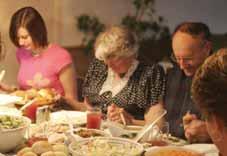
Afriend of mine tells a story about family dinners at the home of her grandmother, where the table would be laden with huge bowls of mashed potatoes, large platters of meat and generous side dishes. Grammy wanted to be sure all were welcome at her table and all were well-fed. One legendary holiday, the dining table cracked under the load!
Here at the Christian Leader, we like to think of our communications efforts as a family table, where we gather to converse and connect. Like food at Grammy’s table, we’ve found that the good stories among USMB are plentiful—too plentiful, in fact, to fit within our bimonthly magazine. We have more testimonies of transformed individuals, families and communities than our 32 pages can accommodate. More thoughtful articles for the feature department, more helpful column ideas and more news.
We look forward to sharing with you via C-Link news and stories that you won’t find any place else.
“ “

Connie
Faber Editor
So we are building a bigger table. This month we begin publishing C-Link, a free, biweekly electronic news digest that offers breaking news, CL updates and stories from our schools, USMB and partner agencies.
Assistant editor Myra Holmes and I will cull through the news stories that come to us from Tabor College, Fresno Pacific University, Fresno Pacific Biblical Seminary, MB Mission, MB Foundation and the International Community of Mennonite Brethren. We will consider information from local churches, district conferences and USMB ministries such as the Historical Commission, National Youth Convention, Ministry Quest, the leadership program aimed at high school youth, and Kindred Productions, the North American MB publisher. We will review updates from the alphabet soup of the larger Mennonite community—MCC (Mennonite Central Committee), MDS (Mennonite Disaster Service) and MWC (Mennonite World Conference), to name just three. Then every two weeks, we will provide C-Link subscribers with the most interesting and informative stories.
We look forward to sharing with you via C-Link news and stories that you won’t find any place else. It’s another way our communication efforts are expanding, and another way to keep us connected. A healthy family is a linked family.
So when you sign-up for C-Link you are getting more than a biweekly news digest. You’re strengthening our USMB family ties. Look for the C-Link sign-up button at www.usmb.org, on the CL Online home page or on our CL Facebook page. Come join us at our newly-expanded family dinner table.









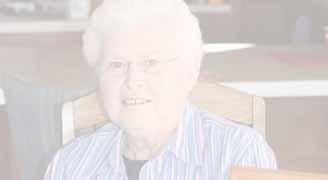



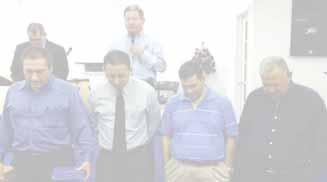


Josh Gonzales

Precious
What is precious to you? The word “precious” isn’t commonly heard today, possibly because it’s not fully understood. According to my dictionary app, precious means “something of great value, something that’s greatly loved or something that’s highly treasured by someone.” It takes time and attentiveness to get to the place where we realize what is truly precious to us. It also takes testing, as nothing is precious to us until we’ve proven it to be so.
I have to admit that when I hear the word “precious,” I think of Gollum from The Hobbit and the Lord of the Rings series who would croak out, “My precious.” In this epic fantasy, this creature’s values, trust, hope and identity are found in a ring, and without it he isn’t complete. In the Lord of the Rings trilogy, Gollum is passionate about seizing the “one ring” that was stolen from him and will do anything to regain his “precious.”
King David writes about what is precious to him: God. Even during times of trouble when he is oppressed, David trusts in God and finds his value, identity and treasure in him. From the time he was a young boy shepherding in the fields, he was learning about God by studying his promises. David knows that those who put their trust in God have no need to fear, because God cannot forsake those who seek him.
The Apostle Peter also writes about what is precious to him. Peter speaks about “the precious blood of Christ” (1 Pet. 1:19), describes our faith as being precious (1 Pet. 1:7), calls believers precious (1 Pet. 2:24), refers to Jesus as the precious cornerstone of our faith (1 Pet. 2:6), and tells about God’s precious promises (2 Pet. 1:4).
Peter learned from the Master that, “where our treasure is (or we could say, what is precious to us), there our heart will be also” (Matt. 6:19-21). Both David and Peter put their hope, security and trust in the eternal things of God that can never be taken from them.
Many of us are like Gollum. We put too much time and energy into things and are passionate about things that have no eternal value. When temporal things that are precious to us are lost or stolen, we may lose our hope, value and security. Let’s learn from David today and make God “our Precious.” When we do, we will have no need to fear, no matter the opposition we may face.
Josh Gonzales was lead pastor at New Hope Church, a Mennonite Brethren church plant in West Valley City, Utah, that closed last month.

“The Lord is a stronghold for the oppressed, a stronghold in times of trouble. And those who know your name put their trust in you, for you, O Lord, have not forsaken those who seek you” Ps. 9:9-10 (ESV).
CHRISTIAN LEADER
April / May 2012
Volume 75 • Number 2
Connie Faber EDITOR
Myra Holmes ASSISTANT EDITOR
Shelley Plett GRAPHIC DESIGNER
Barry Lewis
Cover photo: Monica, Vince and Beth Carrig's adopted Ugandan daughter
The Christian Leader (ISSN 0009-5149) is a gathering place for the people, passions and mission of U.S Mennonite Brethren. The Christian Leader is published bimonthly by the U.S. Conference of Mennonite Brethren Churches. However, the opinions expressed here are not necessarily those of the church as a whole.
COPYRIGHT The articles printed in the Christian Leader are owned by the CL or by the author and may not be reprinted without permission. Unless noted, Scripture quotations are from the New International Version.
READER PARTICIPATION Letters to the editor should be 300 words or less and on one subject. Letters must be signed and include the writer’s city and state. Letters will be edited for clarity, appropriateness and length. Letters will be published, as space allows, unless marked, “Not for publication.” Readers interested in contributing essays for In My Humble Opinion and First Person should contact the editor. Freelance article submissions are welcome; a SASE must accompany articles.
SUBSCRIPTIONS $10 for six issues and $20 for 12 issues ($15, $30 in Canada; all other countries $25 for six issues); $1.50 per copy
CORRESPONDENCE: All correspondence, including subscription questions and address updates, should be addressed to Christian Leader Box 155, 107 N. Main, Hillsboro, KS 67063-0155 Phone: 620.947.5543
E-mail: christianleader@usmb.org
MEMBERSHIP The Christian Leader is a member of the Evangelical Press Association and Meetinghouse, an association of Mennonite and Brethren in Christ editors.
POSTMASTER Send address changes to Christian Leader, Box 155, Hillsboro, KS 67063. Periodicals postage paid at Hillsboro, Kansas.
The Christian Leader is published by

U.S. Conference of MB Churches

Ed Boschman USMB executive director ebed@usmb.org
A USMB dream team?
Deep on the inside of heart and soul, everyone is “all in” all the time. In the mind, where decisions are made, the right calls are routine. Total buy in is never in question. Whether on offense or defense, everyone is flat out sold out to do their part and make good on their assignments. There is a heavy but welcome awareness that the collective impact will be strongly influenced when any one player is holding out.
The head coach is a presence, always there, embodying the mission, vision and ultimate goal of the team. Everybody knows he has been through it before and he understands both the entire season and the current challenge. Even better, the coach really can lead the way because he embodies the critical core values. The squad demonstrates unmistakable clarity and cohesion because the coach is their north star.
The head coach and the owner are completely and absolutely on the same page. Sometimes it’s hard to separate their influence. While there is an awareness that the ultimate victory is in view, it most often seems that is not the biggest thing to them. It’s more like the big deal is about everyone being freed up and called on to do whatever they can, the best that they can, all the time. Behind that, there are clear and powerful expectations about character, attitude and faithfulness. And behind that, everybody knows that pride is a baseline enemy; self-serving egos need to be absent for teamwork to be maximized.
When not in the middle of the fray, the possibility for the owner, coach and teammates to be all in wins the day with ease. When that totally committed attitude is taken into the fray there is room for error and everyone brings a chin-up
partnership that includes friendly forbearance. But when key position players get more of the action, it is harder for those teammates in supportive roles to stay enthused about making the highest possible quality contributions. That is especially true when pivotal players play in ways that marginalize their teammates. There are other reasons that it can be hard to stay all in. A teammate’s error at a critical moment will test resolve. As will the appearance of an ego or pouting or power trip. As will letting up. As will ignoring the coach or the game plan. As will going rogue.
Even when the dream team gets it right, they don’t win every time. They may not get to be league or world champions. But they do make plays and they do win some. They have the affirmation of the owner and the coach and even the fans in the nose bleed section. They each do the right things at the right time in the right way for the right reasons. They give all they have to give. They are all in all the time.
They make a difference. They get better, and others are impacted and changed along the way. Spectators like them because they are genuinely sold out and they live, love and play that way. Because the players believe in and trust their coach and owner, management becomes famous, and thousands sign on for a dynasty.
One of the best things is that everybody shows up for the parties. Celebrating what has happened is exhilarating and anticipating the future is reason enough. Honoring the owner and the coach are pure joy. Experiencing the satisfaction of being on the team is huge. In an almost celestial sort of way, anticipating the future is as good as it gets.
Celebrating what has happened is exhilarating and anticipating the future is reason enough.
Women in ministry
My gratitude to Lynn Jost for his insightful article, “Pondering what pastors preach” (CL, Oct/Nov 2011). As Jost concluded his article, he also noted the importance of inclusivity in the pulpit.
Jost wrote, “I grieve the paucity of preaching by women and believe it needs to change. Scripture seems quite clear in indicating that, when women have adequate preparation, they speak prophetic words and teach.”
Thank you for writing so clearly what many of us have lived. Women of the 1960s who heard God’s call and wanted to remain in the Mennonite denomination were excluded from serving in the pulpit. We were instead encouraged to work toward a degree in Christian education where we could teach children. But we could not study the benefits of exegetical preaching or serve as pastoral staff. In our submission to authority, our call was then diluted. So we obeyed and quenched the Spirit or found other denominations where our call was valued.
Of all the religious leaders in the world, Jesus Christ was the only one who truly valued women and respected their giftings. He let Mary sit at his feet when it was culturally unacceptable for a woman to learn. He inspired Aquila and Priscilla to serve with Paul and possibly co-write the book of Hebrews. Jesus called Rachel Saint and Anne Graham Lotz to teach the gospel to anyone who would listen. And today, this Savior of the world reminds us that time is short and in the last days men and women will prophecy.
Hopefully, as Jost recommends, the church will revisit the issue. Imagine the community that might evolve when the young women of today’s church, along with their brothers, are given the right to speak.
R.J. Thesman Olathe, Kan.
The Christian Leader welcomes letters to the editor. Letters should be 300 words or less and on one subject. Letters must be signed and include writer’s city and state. Letters will be edited for clarity, appropriateness and length. Letters will be published, as space allows, unless marked “not for publication.” Readers wishing to respond to articles published electronically can post comments on our Web site (www.usmb.org/christian-leader) and can also leave comments on the CL Facebook page.
Pacifism
Iam writing in response to the article “Life, politics and Jesus-shaped logic” (CL Dec 2011/Jan 2012). Since joining a Mennonite Brethren church in the 1990s, the teaching of pacifism has been touched on occasionally, being given subservient service to the primary message of the gospel. I have appreciated that.
I want to address the militant pacifism espoused by many. The teaching of this philosophy leads to certain practical applications. Going beyond what I believe is the turning of one’s cheek to threats of harm, it extends this to a nonviolent resistance in any form. In my purview of Scripture, love for God and love for fellow man is the highest priority. Does a nonviolent philosophy fit in with this?
I see love in the Scriptures providing for the protection of the weak and innocent and justice and the pursuing of righteousness, and a principle that there is no greater love than laying down your life for another. In these principles I see no injunction that we are to stand idly by while others trample our family, neighbor, countrymen or fellow world citizens. On the contrary, I see an immorality that would allow such things to happen without standing in the way, yes, even with a violent resistance. Many have done so over the centuries, thus demonstrating what I believe to be this love.
A corrupt organized church combined with a corrupt political government machine in the past has contributed to a repugnance of “ church “ associated violence. This reaction, or overreaction, has led at least in part to this philosophy, which seems to many to carry equal or greater importance than the “meatier “ aspects of the faith such as love, salvation, sanctification, etc.
Despotic political regimes more readily allow “pacifist” religious organizations to enter their countries, giving an advantage to the presentation of the gospel in this sense. However, where the gospel goes, it awakens a man’s conscience to the realization of his fellow man’s worth in God’s sight and of God’s standards of justice and righteousness. This will become threatening to these governments, perhaps with Christian believers reluctantly taking up arms. A “peace” without justice and righteousness has no virtue from a biblical perspective.
James Penrose Bakersfield, Calif.
Enthusiasm characterizes LAMB gathering
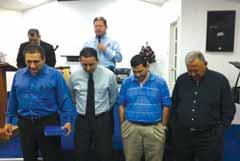
Optimism for the future and excitement about potential church planting marked the annual convention of the Latin American Mennonite Brethren District Conference (LAMB) Feb. 3-5. LAMB is composed of eight mostly Spanish-speaking U.S. Mennonite Brethren congregations in extreme South Texas.
“There’s a growing spirit of confidence and optimism that they really can make a difference,” says Ed Boschman, USMB executive director who attended the convention.
The gathering began Feb. 3 with an abbreviated LEAD ONE leadership and development event at Jesus es mi Paz, Pharr, Texas, led by Boschman and Don Morris, director of Mission USA, the church planting and renewal arm of the USMB. About 45 LAMB leaders attended—nearly double the expected turnout—and the training was well-received.
Delegates and leaders attended to conference business Saturday morning, Feb. 4, at Templo Nueva Vida Community Church, Palmview, Texas. A new district budget includes support for USMB, delegates attending Conection 2012, the USMB biennial convention, and church planting.
“They are interested in planting churches,” says Morris, and are discussing a partnership between Mission USA and Mission (Texas) MB Church to establish an outpost on what’s known as the Seven Mile Road. In addition, Mission USA continues to work with Grulla (Texas) MB Church in outreach initiatives; part of their vision is to begin a multisite church plant in nearby McAllen, Texas. A worship celebration Saturday evening at La Joya (Texas) MB Church wrapped up the district gathering. A highlight of that celebration was a time of prayer and dedication for district pastors and leaders. Boschman prayed for pastors; Morris prayed for newly appointed district leadership (photo). Moises Tagle (far right in photo) is the new district chair, replacing outgoing chair Miguel Flores. Aaron Hernandez (second from left) replaces Juan Garcia as vice-chair. —from reports by Morris and Boschman
BFL plans study conference
The USMB Board of Faith and Life (BFL) will host a study conference in early 2013 focused on a review of two articles of the Confession of Faith: Article XII (The Society and State) and Article XIII (Peace and Nonresistance). Pastors, church leaders and others are invited to attend the event to be held Jan. 24-26, 2013, in Phoenix, Ariz. “Presenters will help us discern what Jesus meant when he called us to peacemaking and how that applies to issues in the contemporary world, as well as what it means to be kingdom citizens above national citizens,” says BFL chair Larry Nikkel of Wichita, Kan.
“A variety of perspectives will be presented in the hope that open dialog can help us all discern what God is calling us to believe and to practice.”
Nikkel says, “We invite people to come with a commitment to listen as well as to speak. We want to covenant to listen well and to understand.”—BFL
Menjares
appointed to FPU presidency



University Board of Trustees as the 11th president of the Mennonite Brethren institution headquartered in Fresno, Calif. For the last 16 years, Menjares has been a teacher and administrator at Biola University, most recently serving as vice provost for faculty development and academic effectiveness. Menjares, who begins at FPU Aug. 1, and his wife, Virginia, are natives and lifelong residents of the Los Angeles area.
Convention to feature transformation stories

“We live in a mission field and the spirit of Jesus is still transforming lives today,” says Ed Boschman, USMB executive director. “We will be telling stories of life transformation throughout Conection 2012. These testimonies—some live and others by video—will show the nitty-gritty process of spiritual birth and ongoing spiritual growth.”
Personal testimonies will be included during the Friday and Saturday morning sessions and integrated into the report from Mission USA, the USMB church planting and renewal ministry. Conection 2012 is the USMB biennial delegate convention to be held July 27-28 in Omaha, Neb.
The story of God’s transforming work in Omaha will be highlighted Friday and Saturday afternoons. Friday convention volunteers will serve Omaha’s downtown neighborhood under the direction of Stephen Stout, Good Neighbor Ministries (GNM) director and a member of Faith Bible Church. Bus tours of the five Omaha churches are planned for Saturday afternoon that will include history and information about the city and a testimony, video or presentation at each church site.
To register for Conection 2012 online or to view the convention schedule and other information, visit www.usmb.org/conection20121. —USMB
byTheNumbers
106 million of the world’s
214 million international immigrants (49%) are CHRISTIANS
60 million (27%) are MUSLIMS
The U.S. is the world’s #1 destination for Christian migrants.
Mexico is the largest single country of origin for Christian migrants.
International migrant is a person living for a year or more in a country other than the one of their birth.
Source: Pew Research Center’s Forum on Religion & Public Life

5 minutes with...
Scott Neufeld
Scott and Brenda Neufeld are Oklahoma Farm Bureau’s Farm Family of the Year. After graduating from Tabor College in 1988, the Neufelds became the third generation to share in operating the 3,000-acre family farm. Scott serves as an elder at Fairview (Okla.) MB Church where he and Brenda also volunteer in junior high ministry.
What does it mean to be chosen to represent Oklahoma agriculture?
My wife and I are downtoearth, ordinary people, but we don’t sit on the sidelines. We work hard to promote causes—teaching farm safety to kids, educating consumers about agriculture and giving input into the new farm bill in Congress.
Has the award affected your efforts?
It’s been a great opportunity to talk about what we do and why. We’ve been interviewed for several newspaper and magazine articles and had the opportunity to give the Lord credit for getting us where we are.
Has it strengthened your influence with Washington?
The award itself just shines a light on what we do, but the influence comes from them knowing we have a real stake in the game. What they do affects us personally so we can speak to them with facts. Part of exercising our faith is speaking with integrity and they recognize that.
How does faith enter into the way you farm?
It took me a long time to realize that everything we have is God’s: the crops, livestock, machinery, everything. When I finally understood that fact, it made it much easier to trust him to provide exactly what we need when we need it.

How do you cope with the uncertainties of farming?
My grandfather gave me a good piece of advice: Whether you have a bumper crop or a crop failure, just be steady. Don’t get rattled by the tough years. If you prepare for them, you will get through them.
Interview by Kathy Heinrichs Wiest
TC expands student housing
A gift from former Tabor College student and ophthalmologist Wilmer Harms and his wife, the late Esther Harms, North Newton, Kan., will provide for more housing options on the college’s Hillsboro, Kan., campus. The new building will house up to 16 students and is expected to be complete and ready for occupancy by fall 2012. —TC



Janzen edits Rejoice!
Jonathan Janzen of Abbotsford, B.C., has been appointed editor of Rejoice!, a daily devotional magazine co-published by Kindred Productions, the North American Mennonite Brethren publishing agency, and MennoMedia, an agency of Mennonite Church USA and Mennonite Church Canada. Janzen recently served as editor of Mennonite Brethren Herald, the Canadian MB publication. He began editing Rejoice! in January.—MCUSA
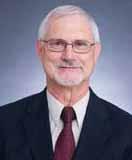
Seminary plans online degree
Ministry education with an Anabaptist and evangelical theme is going online at Fresno Pacific Biblical Seminary (FPBS). FPBS dean Lynn Jost is directing the creation of a two-part online program. The first part will include eight courses. Part two will make these courses part of a 39-unit master of arts degree in ministry. FPBS, part of Fresno Pacific University, plans to offer the first two courses in fall 2012 and two more the following spring. Both sets of courses are funded in part by $500,000 from MBBS Inc.—FPBS
MCC

sale comes to West Coast
The 45th annual West Coast Mennonite Sale and Auction for World Relief will be held April 13-14 on the campus of Fresno Pacific University, Fresno, Calif. A special feature of this year’s sale is a benefit concert featuring recording artists Kim Thiessen and Darryl Neustaedter Barg and presentations by authors of the popular book Mennonite Girls Can Cook. The event benefits the work of Mennonite Central Committee. For more information, visit www.westcoastmccsale.org. —MCC
Counseling program expands
Tabor College taps Braun
Ron Braun, North Newton, Kan., has been hired as vice president for advancement at Tabor College, Hillsboro, Kan., effective Jan. 23. Braun was previously serving as the TC director of development and fills the position vacated by Jim Elliott.—TC
The Marriage, Family and Children’s Counseling program from Fresno Pacific Biblical Seminary will be the first seminary program to be offered at one of Fresno Pacific University’s regional centers. FPU, the West Coast Mennonite Brethren school, has a main campus in Fresno, Calif., and centers in Visalia, North Fresno, Bakersfield and Merced. The MFCC program will be offered this coming fall in Visalia, Calif. Students wishing to finish the 65-unit program in 33 months, the shortest time possible, attend class two nights per week and take one or two weekend courses per semester as well as occasional online classes. Part-time options are also available.—FPU




It was the afternoon before my husband’s funeral. The family was gathered to view Emerson’s worn-out “tent,” as Paul calls it in 2 Corinthians 5:1-2,4.
And there it was. In the corner of Emerson’s casket was a sheet of red, slightly crumpled construction paper, folded in half.
“I hope you don’t mind,” said my daughter-in-law Sherrie. “Hollyn made Papa a card and wanted him to have it. Was it all right for her to put it in there?” Sherrie asked, motioning toward the casket.
“Of course,” I assured her.
I reached out and picked up the card.
“May I read it, Hollyn?” I asked.
“No, Grandma Ruth,” she said. “It’s for Papa to read, not you!”
“Okay. Okay,” I said, hastily placing the red card next to what used to be Emerson and was now just the empty shell he left behind.
The morning of Emerson’s memorial service the family and extended family gathered in the sanctuary for the “reading of the flower cards.” That done, the mortician suggested we move around and say our last good-byes before the casket was closed.
No one moved. Everyone was waiting for someone else to go first. I stood and picked up the red card.
“Hollyn made Papa a card,” I explained, holding it up for all to see. “But I don’t have permission to open it because it’s for Papa to read.”
It took only a couple of seconds for Hollyn to slip off the pew and join me.
“It’s okay, Grandma Ruth. You can open it.”
Hollyn had changed her mind.
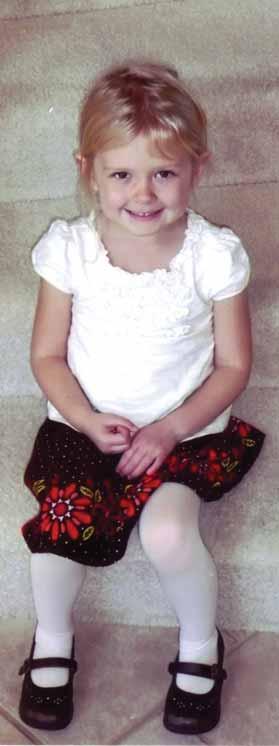
by RUTH NEUFELDT






It seemed like Hollyn had used a whole stick of glue to secure the contents of the card from unauthorized eyes. With much patience, I peeled the card open without too much damage.
What were those two circles and squiggly marker lines?
Hollyn’s mom, Sherrie, explained: “It’s a sink.”
I was puzzled. “A sink?”
Hollyn cleared up my confusion.
“It’s so Papa can wash before he goes to see Jesus. Dead people have to be washed and clean.” (Small children can get by with being blunt and honest.)
So that was it: The two circles were a double sink. The squiggly lines were the pipes that drained the sink.
“Yes, Hollyn, we all have to be washed and clean before we see Jesus.”
Papa Emerson was washed in the blood of Jesus when he was 13 years old. He was ready to meet Jesus. Hallelujah! Are you washed and ready?
Ruth Enns Neufeldt and her husband, Emerson, were married for 59 years and lived in Buhler, Kan., where Ruth continues to reside. She is a member of Buhler MB Church. Her granddaughter was 4 and one-half years old when she made this special card for her grandfather.
Emerson Neufeldt devoted himself to supporting the evangelism efforts of others—around the world, on U.S. college campuses and in his home community. If there were any chance that someone would be born into God’s family, Emerson would throw his support behind that outreach effort. With her simple drawing, Emerson’s granddaughter continues his legacy of pointing others to Jesus.






The Easter Surprise
Celebrating the first day of a new kind of week






by KURT WILLEMS

When you are small, the wonder of an Easter egg hunt is exciting. But as you grow older, the awe of the experience begins to fade. I remember a particular Easter when I had to make a choice: Would I listen to my older cousin or would I do what was right?
It was Easter, and I was six. All of the grandkids were sent upstairs into the bedroom while the adults went outside to hide eggs. The problem was that the bedroom window faced the main part of the yard. What my cousin saw as an opportunity, my gut told me was an obstruction of justice, a desecration of the wonderful art of hide and seek, the surprise of finding Easter eggs.
Inevitably, I followed his lead and that day we were like the spies sent into Jericho. We watched from that upstairs window as the adults hid the eggs. Rather than experiencing the wonder of actually discovering eggs, we knew exactly where to look. The whole experience was sanitized.
John’s resurrection account
There is a one-in-four chance that on Easter Sunday your church community will reflect on John 20: an account of the greatest event in history—the resurrection of Jesus. The resurrection is the most beautiful thing that the church has to offer the world. Nevertheless, each year it becomes the “old familiar story” instead of the fresh account of God transforming all of reality. It is as though the resurrection loses its shock value, that it has become sanitized.
It is interesting to see how the author of John’s gospel tells his story. There are some striking themes that can very easily be missed if we are not careful. Notice how this good news of Jesus begins: “In the beginning was the Word, and the Word was with God, and the Word was God. He was with God in the beginning. Through him all things were made; without him nothing was made that has been made” (John 1:1-3).
The first line of this historical story should jump out and scream of familiarity. For a 1st-century Jew this spoke volumes. Whenever we read the New Testament it is a good to remember what the original readers had in the back of their minds. Or as one author has put it, we need to remember the Bible Jesus read.
John’s story of creation
What I am talking about is the “principle of first mention.” We need to ask ourselves: Where else in the Bible does it say something similar? In this case we would say, “Oh I know. Genesis 1.” So we ought to read whatever John is writing with the original “in the beginning” story in mind.
John’s gospel has something to communicate about humanity and the whole cosmos. This is a story about creation. John wants us to understand that Jesus was with God before the creation of the world and then chose to become part of God’s earth as a human being. Jesus’ life not only enters into cosmic history, but somehow affects all of creation itself. It is very important to keep this in mind as we return to John 20.
Chapter 20 begins with an interesting detail that gives us the exact day that Jesus rose from the dead and also a clue into something deeper. The writer states: “Early on the first day of the week” (John 20:1, emphasis mine).
Now what does this have to do with anything? Couldn’t the author just as easily have said “on Sunday”?
It seems that John is emphasizing something quite specific. This minor detail is so important that later in this same chapter he says again: “On the evening of that first day of the week…” (John 20:19, emphasis mine).
A new kind of week
What is John getting at? Remember the start of his book? John makes sure that we have the Genesis creation stories in the back of our minds as we read the rest of his gospel. It is important to John that we see clearly the flow of the passion narrative. Jesus dies on the sixth day of the week (the same day in which humanity was created in Genesis), rests in the ground on the seventh day (just as God rested) and then is resurrected on the first day of a new week. Or to say it another way, Jesus’ resurrection happens on the eighth day or the first day of a new kind of week.
N.T. Wright describes it this way in his book Surprised By Hope: “John 20 stresses twice (in verses one and 19) that Easter is the first day of the new week. John has so ordered his gospel that the sequence of seven signs, climaxing in the cross of Jesus
on the sixth day of the week and his resting in the tomb on the seventh, functions as the week of the old creation; and now Easter functions as the beginning of the new creation. The Word through whom all things were made is now the Word though whom all things are remade…. Jesus’ resurrection is to be seen as the beginning of the new world, the first day of the new week, the unveiling of the prototype of what God is now going to accomplish in the rest of the world.”
John is trying to help the reader understand that Jesus’ resurrection is the beginning of a process of God recreating the world. Jesus is re-created first, and then someday the rest of humanity who are in relationship to God will be re-created along with the rest of the created order. When Jesus walks out of the tomb on that first Easter morning, hope for something more invades reality. God in Christ begins a whole new creation in the midst of this world’s brokenness.
Our new world
In Revelation 21 and 22 John describes in great detail what the world will be like when the new week that Jesus inaugurates through his resurrection comes to its completion. We read that the heavenly New Jerusalem will come down to this earth—not to a destroyed planet that God has given up on but to this one. Although the word “new” gives English readers the sense that the “new heaven and new earth” will be brand new, the Greek word “kainos” literally means “new in nature or quality.” It is a categorical mistake to believe that God will give up on this world and replace it with a brand new one.
According to John, eternity in God’s restored earth will be the completion of creation, the beautiful union of heaven and earth. “There will be no more death or mourning or crying or pain, for the old order of things has passed away” (Rev. 21:4). Poverty, pain, sickness, injustice, violence and even death will all cease for eternity as God consummates the fullness of the kingdom of God!
Article 18 of the Mennonite Brethren Confession of Faith says it this way: “All God’s children will be united with Christ when he appears, and they will reign with him in glory. Pain, sorrow and death will be abolished, and the redeemed will be gathered into the new heaven and new earth where together with
the angels they will worship God forever. God will make all things new, and God will be all in all. This is the blessed hope of all believers.”
Paul reminds us of this hope in Romans 8, stating that this will be a day when “creation itself will be liberated from its bondage to decay and brought into the freedom and glory of the children of God.” For now, we have the Holy Spirit who “groans” within us in the midst of the brokenness of our current reality and invites us to do something about it.
We are empowered to partner with God to remind our world that it isn’t always going to be like this. We, the people of God, are invited to live as though tomorrow’s new creation has already begun. Because according to John 20, indeed it already has!
A new gardener
Mary Magdala stands outside of the tomb weeping when the gardener shows up. This seems a bit familiar as well. Back to the original creation story we go. Adam was placed in a garden as its overseeing gardener and given a green thumb to nurture it, to make creation flourish. Now a new gardener has arrived.
Mary doesn’t realize it at first, but this gardener is everything Adam and humanity failed to be: God’s untainted image-bearer. Jesus is the beginning of a new humanity and has called us to not weep as though we have no hope but to live in light of the new week of creation that he inaugurates.
As we move toward Easter Sunday, my hope is that the resurrection fills us with a sense of wonder. Christ’s resurrection should be more like the surprise of a child stumbling across an egg in the yard and less like viewing things from an upstairs window. We can continue to let the “old story” be redundant and sanitized, or we can realize that Easter is about God doing something fresh in the world. “Christ is risen” means that a whole new creation has been born in the midst of this old one! May our culture see glimpses of the resurrection through our churches as we live as conduits of the new week of creation.
Kurt Willems is a final year Master of Divinity student at Fresno Pacific Biblical Seminary in Fresno, Calif. He is a freelance writer for various print and online publications, including his personal blog hosted by the religion Web site Patheos.com.
by VELMA GOERTZEN as told to Connie Faber


Twenty-six years ago this Easter my 21-year-old daughter and I sang Handel’s “Messiah” with the Hutchinson (Kan.) Oratorio Society. Two weeks later a drunk driver killed my loving Beth. When I remember that day, the pain of her loss is as fresh as it was then.
My husband, Stan, died suddenly of a heart attack when Beth was 10 and her brother, Kerry, was 8. My children and I became a close-knit team. Beth was my confidant and friend. She never sat still and was a good athlete who loved sports. She loved music and cats. She was loyal to her family and interested in family history. Beth was a good listener and looked out for those who weren’t popular, were struggling or needed a friend.
After graduating from high school, Beth attended Grace College in Winona Lake, Ind., for one year. There she met Rick Battis, and they were married on her daddy’s birthday—July 23, 1983. That was Beth’s way of having her daddy at her wedding.
After they were married, Beth and Rick worked in Hutchinson, Kan., but lived in nearby Buhler, right across from Buhler MB Church. They were youth sponsors and hosted their Sunday school class in their home because there wasn’t room in the church.
Beth and Rick loved working with teenagers and felt God calling them to full-time ministry in Christian camping. So in the spring of 1985 they were preparing to move to Wisconsin where they would spend one year as interns at Camp Forest Springs.
Beth was seeing a doctor in Wichita, Kan., for help with her food allergies. Her last appointment with Dr. Hugh Riordan was the evening of April 18, 1985. As he told Beth goodbye, Dr. Riordan said, “Go and have a good life.” A half-hour later as Rick and Beth were traveling on an ele-


vated stretch of I-35 in Wichita, their car was hit head-on by a young man driving the wrong way up the off ramp. One instant she was talking, making plans and going on with life and the next minute Beth was in heaven.
After the accident, I lived in a fog for a month or so. As I was coming out of that daze a friend said to me, “I don’t know how you can ever forgive him.” I was so overwhelmed with grief and loss that the thought of forgiving the man who killed Beth hadn’t even crossed my mind. Beth was gone—that’s all that mattered.
When I lost Beth I had to redefine my faith. Do I really believe all the things I’ve said about God? How could the accident really be God’s will for Beth? I finally concluded





One instant she was talking, making plans and going on with life and the next minute Beth was in heaven.

CONNIE FABER
that I could accept that God allowed Beth to die, but it may not have been his perfect will for her.
As I came out of that deep grief four or five months later, I wanted to know about the guy that killed my Beth. I visited the Sedgwick County Courthouse and the office of the judge assigned to the case. I learned that on the day Beth was killed the driver had been stopped three or four times that morning for drunk driving, and he kept driving. Between the date she was killed and his first court date the driver had three more DUIs.
I was angry. “Why haven’t you picked him up?” I asked. “He killed my daughter.”
I was told a warrant was out for his arrest and that the police knew where he lived. “We’ll get to him someday,” they said. This made me very angry. I haunted that judge’s office. Finally they suggested I visit a mediation service run by the General Conference Mennonite Church (now Mennonite Church USA). I think they were afraid of what I would do. Evidently my anger was pretty bad.
Then one Monday morning when Rick and I went to the judge’s office we learned that the driver was in the midst of his court hearing. Today they would tell the victim’s family about a hearing, but they didn’t do that then. God had us there at just the right moment.
That morning I looked into the face of the man who killed my daughter and listened to him defiantly say, “I didn’t do it. I don’t remember doing this.” I was overwhelmed. How could I forgive him? How could I forgive when he doesn’t acknowledge what he did?
This started my battle of forgiving and taking it back; forgiving and taking it back. Two verses became very meaningful to me. Colossians 3:13 says to “forgive as the Lord forgave you.” Romans 12:19 says, “Do not take revenge, my dear friends, but leave room for God’s wrath, for it is written: ‘It is mine to avenge; I will repay,’ says the Lord.”
I had to forgive the young man who drove drunk so that God could heal me and I could move on. But I struggled a long, long time. I withdrew from people because they were trying to move me along and I wasn’t ready. It was a lonely, painfully long journey. Finally I gave the fight to God and asked him to show me how to forgive. “You know how hard I struggle to forgive,” I told God, “but it’s in your hands.” I wrote a prayer that I repeated often as I struggled to forgive:
“Lord, I can’t do this on my own. The decision to forgive is a daily struggle. Sometimes my blame and anger fuel me, and I keep fanning the flames with
more and more negative thoughts. Right now, I surrender my thoughts to you. Please take these angry, bitter feelings of blame and teach me to replace them with your Word, with prayer, with time spent helping others and with remembrances of your forgiveness. I choose to trust you to guide me through this process. Amen.”
One of the most powerful lessons I learned during this time was that you know you’ve truly forgiven when you begin to pray for someone and wish him well. So I began to pray for the driver. My prayers were pretty feeble at first. But I did pray for him, and I still pray for him.
I have had no contact with the driver. I’ve never heard an “I’m sorry.” I have wished for a letter or some acknowledgement, but I don’t expect that anymore. The driver served a total of maybe two years in prison. Today he would have been given a tougher sentence. The “impact statement” that family members can make now wasn’t available to us then. Was justice done? No, but it is out of my hands.
One of the things that helped me heal was joining The Compassionate Friends, an organization that provides grief support after the death of a child. Going through this grief with other families—mostly Christian families—was very important to my healing.
The Compassionate Friends is not a Christian organization, and I thought for many years that local churches need a grief support ministry. Three years ago we started GriefShare, a Christian grief recovery support group, in our church. We don’t know why God asks us to endure hard things. But as a GriefShare leader I’m doing something with my grief other than just living with it. I can help someone walk this road.
I’ve learned a lot about grief and forgiving. I’m still learning. I always use the words, “You find a new normal.” I’ve learned that there is no such thing as getting over the death of someone you love. You can’t get over that love. You can’t forget it.
I know now that forgiveness is not a one-time thing, and I continue to forgive the man who murdered my daughter by his choice to drink and drive. I praise God for being so good. He has healed my heart and my family’s heart.
Velma Goertzen lives in Inman, Kan., and attends Buhler (Kan.) MB Church. She is a registered nurse and recently retired after working 20 years for Health-EQuip, a home medical equipment service company in Hutchinson, Kan. She has served as a Medicare advocate, making numerous trips to Washington, D.C.
An orphan story
A tale of two congregations and the Ugandan kids that changed them
The Father of the fatherless must look upon Uganda with a special ache. Slightly smaller than Oregon, this country in the heart of Africa is home to an estimated 2.7 million orphans due to AIDS, malaria and violent conflict. These orphans are usually taken in by extended family, where they are frequently treated as second-class family members, receiving food and clothing only if there’s enough to go around. Often, there isn’t.
Take Moses, for example. His mother, under pressure from her own father, had left the boy to die in a swamp. Someone found him gagged and covered with mud but still alive. A woman in the community cared for Moses, but the small amount of food she could provide was not enough to bring him back to health.
The same Bible that describes God as Father of the fatherless instructs his followers to “look after orphans and widows in their distress” (James 1:27).
Two U.S. Mennonite Brethren congregations are responding to that directive by meeting physical and
spiritual needs of orphans in Uganda. Discovery Bible Fellowship (DBF), Collinsville, Okla., provides for about 50 children at Calo Me Lare, an initiative of DBF through Project Hope Worldwide. New Life Fellowship, Grant, Neb., is working with another Grant church to care for about 100 orphans at a “carepoint” established through Children’s Hope Chest.
Derk Madden, pastor of DBF, recalls the 2008 church planting mission trip that prompted his congregation’s involvement with children like Moses: “As we went from hut to hut, there was this throng of children that followed us, some of them like two years old. People told me those were orphans. When you see something that is so blatantly wrong or needy, you can’t just go home and not do anything about it.”
Establishing Project Hope Worldwide (PHW) as a separate nonprofit allowed the church to tap into other funding sources. This month PHW will hold its third annual Kwero fundraising event, which includes high quality entertainment, silent and live auctions and multimedia presentations demonstrating the need and showing progress on the development of the project. For more on Kwero, see http://kwero2012.blogspot.com/.
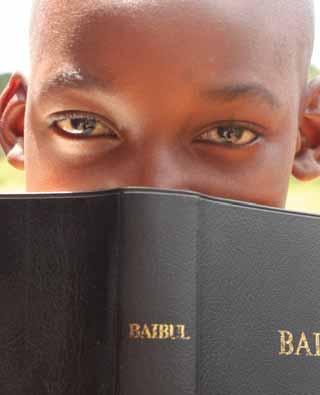
Corporate gifts and a child sponsorship program have enabled PHW to move quickly to implement their vision of creating a village for orphans. Over the course of several visits to Uganda, PHW was led to a site in Lira, a city of 1.5 million people; to missionaries Andy and Cami Flege, who now serve as on-site directors; and to Ugandan Emiku Dennis, who provides local leadership and cultural guidance.
By March 2011, newly formed “families” consisting of a Christian widow and up to eight orphans began to fill the houses at Calo Me Lare, a Ugandan name meaning “village of redemption.” In addition to eight orphan homes, the village soon had an administration building that serves as a gathering place for Sunday worship as well as a school during the week. For more on Calo Me Lare visit http://www.projecthopeworldwide.org/.
Establishing a village of orphan homes is one way Discovery Bible Fellowship, Collinsville, Okla., is providing for the spiritual and physical needs of Ugandan orphans like Sarah.
Meanwhile, New Life Fellowship’s involvement in Uganda began with a seemingly small thing: James Harms, who attends Grant (Neb.) Evangelical Free Church (GEFC), read a book on the plight of orphans in Africa. “We need to do something for orphans in Africa,” he thought.
That spark of conviction led to a 2008 meeting with leaders from New Life, GEFC and Children’s Hope Chest, a ministry that connects Christian communities in the U.S. and Canada with orphans throughout the world. The two Nebraska congregations decided to partner in launching a Children’s Hope Chest “carepoint” in remote Kayango, Uganda.
Unlike Calo Me Lare, the carepoint is not a residential orphanage but a gathering point and resource center to help the most destitute orphans with both practical and spiritual needs. Individual sponsorships of $34 a month provide orphans with meals, school supplies and clothing. Once a week, “disciplers” from the nearby village, hired by Children’s Hope Chest, come to the carepoint to provide spiritual teaching.
In March 2009, the Grant churches held an official “launch” service, asking for sponsors for orphans to be served at the carepoint. Based on the sizes of the two churches—together fewer than 250 people—and typical sponsorship rates, Children’s Hope Chest recommended a goal of 30 orphans. But the churches prayerfully chose a God-sized goal of 100. By the end of the launch day, all 100 orphans were sponsored.
For both DBF and New Life, an important part of their involvement in Uganda is just that—involvement. They do more than send money; they go. That was part of what attracted New Life to Children’s Hope Chest. “They expected that we would go,” says Vince Carrig, pastor of New Life.
About half a dozen teams, comprised of folks from New Life, Grant Evangelical Free and the community, have gone to Kayango to visit the carepoint since it began in 2009. They have met sponsored orphans and local leaders, taught children’s programs, overseen the digging of a well and a pit latrine, built a
kitchen and trained local pastors. And they’ve built relationships, the value of which can’t overstated in this culture that values relationships over tasks.
While Ugandan staff led by Emiku and the Fleges handle the day-to-day operations of Calo Me Lare, Madden and DBF continue an active role in the ministry. Three teams have traveled to Uganda for shortterm ministries. The church expects to continue that pattern, sending about 30 people to Uganda each year. Depending on the expertise of the group, shortterm teams have done hut-to-hut evangelism, vacation Bible school, child development counseling and HIV/AIDS testing.
Even in a short time, these efforts to help Ugandan orphans seem to be making a difference. Moses, the child abandoned in a swamp, came to Calo Me Lare at age three and has become part of a new family led by a Ugandan Christian widow and filled with several “brothers” who are also orphans. And the children who receive food and clothing at the Kayango carepoint are visibly healthier than others in the community.
The work is not without challenges, as both projects navigate cultural differences. One of the early Grant teams helped build a large room at the

Kayango carepoint which they intended to be used as a kitchen. While the building is proving useful, it is not being used as a kitchen. That frustration has helped the Grant churches understand that they have much to learn.
“We don’t want them to become Americans,” Carrig says. “We desperately want their partnership.”
Those who have gone to serve these Ugandan orphans find themselves transformed.
After participating in the shortterm missions and becoming PHW financial sponsors, long-time Discovery Bible Fellowship leaders Dennis and Margie Balzer are retiring from their jobs and will spend the first year of their retirement in Uganda supporting the current staff at Calo Me Lare. They will move to Uganda in May.
“Leaving grandkids is probably the hardest thing about going,” admits Dennis, “but we’re committed for a year and will see how the Lord leads and how productive we feel we are.”
For Vince Carrig, pastor of New Life, and his family, loving orphans in Uganda has meant adding a family member. While on a short-term mission trip, Carrig met Monica, his family’s sponsored child, who is pictured on the cover. He felt God nudging him: “You are her father.” Time and prayer confirmed for the family that they should explore the possibility of adopting. Obstacle after impossible obstacle fell, and the Carrigs brought Monica home in December 2011. “I think the Lord has a great plan for her,” he says.
For more stories of lives transformed by working with Ugandan orphans and extended articles on Calo Me Lare and the Kayango carepoint, visit www.usmb.org/chleader. —Kathy Heinrichs Wiest and Myra Holmes
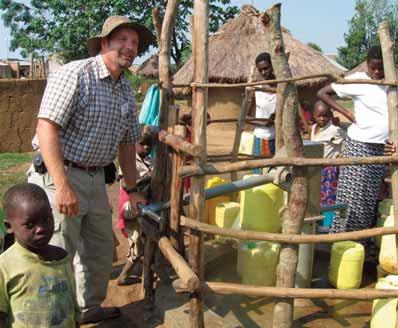


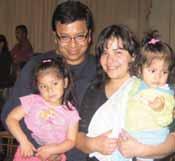
Troy Kemling, a teacher from Grant, Neb.,stands next to a bore hole that the 2010 Nebraska team built to serve a remote Ugandan community. Providing for the educational needs of the children served by their "carepoint" is a priority for the Grant congregations.
VINCE CARRIG
Borisov builds bridges
Slavic ministries director seeks to reconnect with Russian-speaking MBs
Although Aleksander “Aleks” Borisov is on the pastoral staff of a U.S. Mennonite Brethren congregation, his initial knowledge of USMB was limited, to say the least.
“I knew two things,” he says, “first, the letter M and second the letter B.”
It was nothing more than extra letters at the end of the name of his Spokane, Wash., church: Pilgrim Slavic Baptist MB Church.
Unfortunately, Borisov’s experience is not unique. On any given Sunday, 34 of the 194 USMB congregations worship in Russian—30 on the West Coast in the Pacific District Conference (PDC) and four in the Central District Conference (CDC). But for many of these Slavic congregations, their USMB connection is “just a signature on paper and nothing else,” Borisov says.
As the USMB’s new Slavic ministries director, Borisov says, “I’m trying to change this situation now.”
As waves of Russian Christians immigrated in recent decades to the U.S. from the former Soviet Union, they found an advocate and financial partner in the USMB, a church formed by immigrants from the Ukraine and South Russia in the late 1800s.
“We welcomed them with open arms,” says USMB executive director Ed Boschman.
But too often the relationship stopped there, and members of the same national church family felt like strangers.
That didn’t sit well with Boschman, the Leadership Board or other USMB leaders. So a new, half-time staff position was formed and funded through a partnership with USMB, PDC, CDC and MB Mission to build bridges between the Slavic MB churches and the rest of the USMB family.
“The goal was to develop a healthier partnership for the sake of stronger ministry and for mutual edification and growth,” Boschman says. “It seemed the best way to do that would be to have someone who could help us bridge that relationship.”
After an extensive search, Borisov began serving as the USMB director of Slavic ministries in September 2011. Borisov is a first-generation immigrant himself, having come to the U.S. in 2005, and speaks both English and Russian. He is active in a Slavic MB church, lives near many other Slavic MB congregations and is well-respected within the Slavic community.
“He’s an enthusiast, a visionary, an idea guy,” Boschman says. “He’s on a mission to help us follow through and build this relationship.”

Plus, Borisov’s part-time position as pastor of education at Pilgrim allows him the flexibility to take on this new role. In his pastoral role for this congregation of over 800, Borisov helps organize seminars for couples intending to marry, mentors for newly-married couples, Bible studies, leadership training programs, short-term mission orientations, small groups and much more. “Anything that has to do with education I’m involved in,” he says.
To build bridges between Slavic MBs and the larger USMB family, Borisov begins with prayer. “What I want to accomplish I couldn’t do by ordinary work,” he says. “I need a miracle in every step.”
In addition to personal prayer, he gathers a group of Slavic supporters every Friday before dawn. They pray not only about Borisov’s ministry hopes and dreams but also for an awakening among the Slavic community and
Because Aleks and Vera Borisov immigrated in 2005 from their home in Russia to the U.S., Aleks is uniquely qualified to minister to USMB Slavic congregations.
ALEKS
BORISOV
churches and for their own equipping as personal evangelists.
Only after laying this foundation of prayer does Borisov work at connecting with Slavic MB churches through letters, phone calls and visits. When he visits a Slavic MB congregation, a good sermon is a must and earns him credibility and opens doors.
“I pray God will give me the right message for each church to reach the heart,” he says.
Often after the service, he meets with pastoral staff and leaders.
“I have to be prepared to give answers for very many questions,” he says. Questions not only about the Mennonite Brethren but also about “the whole area of life.” He’s grateful for broad experience in church ministry and missions, both here and in Russia, from which to draw.
In addition, Borisov wants to help equip these congregations with seminars on topics like evangelism and developing small groups. It’s important, he says, to not only be accepted, but to be “a good servant.”
It hasn’t been easy. While Borisov describes Slavic MBs as very loving, having open hearts and open




doors, they also have a wariness and sense of independence that comes from surviving past persecution and living now as foreigners. “We are aliens,” Borisov says. “We are alone and have to survive alone.”
Given that, building trust will take time. Borisov notes the disciples’ first assignment was simply to be with Jesus. “I think this is a key to any relationship: to spend more time together.” He dreams of Slavic, Anglo and Hispanic MBs visiting each other, praying for each other and working together toward common goals.
One such goal is church planting. The USMB has set a goal of planting 60 new churches in the next 10 years; Borisov wants 10 of those to be new Slavic MB churches. He and other USMB leaders are looking both at starting churches from scratch and at the possibility of adopting established, unaffiliated Slavic churches into the USMB family. These adopted churches could provide a much-needed model of a good relationship, he says.
If God blesses efforts to better connect, “MB” will be more than two letters at the end of a church name; it will signify a ministry partnership that both parties value. —Myra Holmes



Buying a “lighthouse”
SDC churches help Kansas congregation purchase facility
Think “inner city” and the images that come to mind are probably not far from the daily realities of those in the neighborhood around Lighthouse Community Church, Wichita, Kan.
“We definitely deal with a lot of broken-hearted people,” says Pastor Jerry Willhite. “We try to give hope to people who are struggling.”
Hope comes first through Christ, so the church emphasizes discipleship, asking for a year-and-a-half commitment to training in the Word and in prayer. Lighthouse also works to meet physical needs through food and clothing pantries and a mobile medical clinic.
The ministry is growing in exciting ways. They’ve begun a promising Bible study in a similar neighborhood, and Willhite expects their small membership of 35 to roughly double this spring when a membership class concludes with baptisms and welcoming new members.
But ministry growth in an urban neighborhood doesn’t necessarily translate into financial growth. Sometimes it means taking on more need. So this fall when the building that Lighthouse had been renting for the past eight years came up for sale, the congregation faced a dilemma.
This fairly large church facility is perfectly situated in the heart of the community, where
people who need Christ and need help can easily stop in. The congregation wanted to stay in the building but hadn’t even been making their modest rent. Willhite says, “If this was going to happen, God was going to have to bless us with it.”
Word of the need spread throughout the Southern District Conference (SDC), and the SDC churches responded. First MB Church (FMBC), also in Wichita, dedicated their entire Thanksgiving offering to Lighthouse—enough to cover about half the purchase price. FMBC also gives hands-on support as volunteers help Lighthouse with outreach events such as a neighborhood BBQ in summer and a turkey dinner give-away around Christmas.
Jana Hildebrandt, FMBC pastor of outreach and assimilation, says the larger, more suburban congregation is grateful for such opportunities to serve. “We want to be part of the Lighthouse story,” she says.
Funds from Lighthouse and the SDC churches will help meet the rest of the building cost.
“God’s called us to ministry here, and this is a difficult area,” Willhite says. “So we’re just very thankful that God is using these partners to enable us to do what God is calling us to do.” —Myra Holmes



Celebrating God’s Faithfulness Mission USA


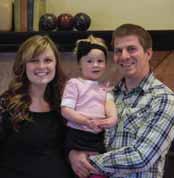

















(Above) Associate Pastor Phil Wiebe, wife Melissa and daughter Ella
(Right) Lead Pastor Tom Mertz and wife Aimee
Don Morris Mission USA director
The work of our hands
When greeting a person with a handshake, have you ever noticed not only the variety of shakes but also of hands? I think it’s an interesting exercise to gauge a person’s work habits, grooming and personality by their handshake and also by their hands.
The other day I shook the hand of a man who just about crushed mine. It was quite the bear paw. His hands were huge and rough. So I figured out quite quickly that he worked outdoors, had a lively robust personality and that “Ouch. That handshake hurt!” I tried mightily to keep at least a half-grin on my face.
I’ve also had those handshakes that feel like a wet fish. You know the kind where the other person just sort of limps their hand into yours. You are then responsible for creating all the action of the handshake, because it certainly isn’t going to be generated by them. Usually these people have quiet, unassuming personalities. They are probably fearful of doing hand damage, so they keep the shake to an absurd minimum.
Then there are those shakes that are just right. Both shakers are giving about the same amount of hand pressure and just the right kind of action. It’s the kind of shake that is encouraging and invigorating, and you immediately know that this is a person you can connect with on a higher level. It’s easy to smile when getting one of those handshakes.


Hands are important, are they not? Psalm 90:17 says “May the favor of the Lord our God rest on us; establish the work of our hands for us, yes, establish the work of our hands.”
When thinking about a new church plant project or a new church health initiative, I often envision all the hands that will be involved in getting it off and running. Hands that vary in size, shape, roughness and tenderness. It takes all kinds of hands to effectively start a church from scratch— all in order to reach more people with the message of Jesus.
Maybe you have hands that God wants to use to help start a new church. Maybe God is calling you to get your hands a little dirtier, a little stronger, a little rougher than they are right now. To have hands that go to work on a mission.
Take a look at your hands. Is God calling you to use them differently than you have been? Not that how you have been serving has been wrong. But maybe, just maybe, God would like to use your hands to firmly grasp his in a new mission—a life-changing mission for the transformation of individuals, families and communities in the name of Jesus. Lord, establish the work of our hands.
For more info on how you can be involved, go to www.usmb.org/mission-usa







—2011 Liberty University Online Research: Thom Rainer, president and CEO of LifeWay Christian Resources.
Need escalates for church planters
Recruiting gifted, qualified church planters is a growing priority for Mission USA, the USMB church planting and church health ministry. As the vision of planting six new churches by the end of 2012 unfolds, the bulk of the work in starting these new churches will be on the shoulders of leaders who have what it takes to get the job done right.
In light of this, the eight USMB staff members have adopted a six-month theme of praying for new church planters and looking for church planters within their individual spheres of ministry.
To date, several names of potential planters have been channeled to Mission USA.
“I have had names come to me from many sources, including our USMB staff,” says Don Morris, Mission USA director. “Some names come from our MB family and some are names from outside our family.
“Another avenue for finding church planters comes from our district leaders,” says Morris. “In fact, district leaders quite often take the lead in discerning leaders who have the capabilities to start something new.”
While Morris is thankful for the growing list of names, he is quick to emphasize the importance of carefully assessing potential church planters.
“Although many names may come to us, we need to make sure that these are leaders who have the right kind of gifts,” says Morris. “Otherwise, it will be detrimental to us as we seek to plant churches and to the leader and his family if they find themselves in a failing environment,” he says.
Finding qualified church planters has become an issue for this year as well as for coming years. Our vision is to plant 60 churches in the next 10 years—six per year. This will require a pipeline of church planters who are in various stages of development. Some leaders will need to spend time in a current church plant environment to learn how to plant a church from the ground up. Other leaders may need experience in preaching or leading teams.
Mission USA is in the process of developing, along with district church planting boards, a system that will enable church plant interns and apprentices to work their way through a prescribed plan of preparation.
“Just yesterday I had a very strong church planter candidate ask me, ‘What do I need to do to get ready to plant a church?’” says Morris. “That is exciting, because it tells me that they are in it to do it right, not just to do it. We want to reduce the number of failed church plants to as low a percentage as we can. To do this, we need to develop and train excellent planters.”
Morris says the national average, for all denominations, for failed church plants is about 32 percent. The USMB failed rate is now around 20 percent.
“If we can keep it there or below, we know we have done a good job of choosing, assessing and preparing church planters,” Morris says.
Morris invites all USMB churches to be in the ongoing mode of discerning church planters. With 60 new churches on the horizon over the next 10 years, the need is obvious. “With God, all things are possible!” says Morris. —Mission USA news
Utah church closes
New Hope Church in West Valley City, Utah, a twoyear old church plant supported by Mission USA, the USMB church planting and church renewal ministry, the Pacific District Conference and key stakeholders, has closed. The church had its final service March 4, the day on which the resignation of Josh Gonzales, lead planter, took effect. Several factors led up to the closure, including declining attendance and a desire for the Gonzales family to
concentrate on their own needs. Members of New Hope have been encouraged to find a church home at one of the other USMB churches in the Salt Lake City area.
“It’s not easy to announce that a church plant has closed,” says Don Morris, Mission USA director. “During its short tenure, the church witnessed several people become followers of Jesus. For that we give thanks!” —Mission USA
J.L. Martin
Cultivating a heart for service

You have probably heard it said: “Youth are the church of tomorrow.” I disagree. I believe that children and youth are the church today. When we make statements like the one above, we give our young people an “out” from what God has called each of us to do. We offer middle school and high school students opportunities to serve and to go on mission trips. What about our children? Do we think they are too young to serve?
One of my most rewarding ministry times is when our children are given the opportunity to serve others. This happens at Hesston MB Church (HMBC) in several ways. Probably the most common is our monthly service projects for 5th and 6th grade students. As I prayed and studied this age group, I realized that this group is at a great stage of development. They are moldable, are seeking who they are and are discerning their gifts. So I decided to give them a wide range of service projects, giving them the chance to give back in practical ways.
Service projects for 5th graders and older:
• Raking leaves for the elderly.
• Delivering Valentines and playing games with residents at the nursing home.
• Cleaning and completing various projects at a homeless shelter.
• Preparing boxes for Operation Christmas Child and school kits for Mennonite Central Committee.
• Work projects around the church.
Wondering if this was chaotic? We have a large group, but they were so engaged and excited when they had the opportunity to serve that it went

smoothly. We have received many cards and emails from the people we served that talk about the maturity of this group and the hope they have in the future. You might expect our midweek attendance to decrease because of the service projects, but it has remained consistent.
What about service projects for younger children? I have a four-year-old daughter. Can she serve too? Absolutely! I have been blessed by how God has used families to serve at HMBC. Each quarter, I plan at least one family service project. These are geared to children of all ages and their parents or grandparents. You have to be a little more creative with the younger children, but they also have done some great service projects.
Service projects for 4th grade and younger:
• MCC kits.
• Clean up at local schools.
• Cards and caroling at a nursing home.
• Taking the offering or serving in other ways during worship services.
• Church workdays.
• City work projects; we painted playground equipment and cleaned up local parks.
• Scavenger hunts collecting food for local food banks.
I challenge families and church leaders to look for opportunities for children to serve at a young age. We expose our kids to sports and academics at younger and younger ages. What would happen if we developed a heart of service at a younger age too? I think we would see our churches, communities and world dramatically impacted for the better. Let’s help our children experience and understand Colossians 3:23-24: “Whatever you do, work at it with all your heart, as working for the Lord, not for men, since you know that you will receive an inheritance from the Lord as a reward. It is the Lord Christ you are serving.”
J.L. Martin is pastor of children and family at Hesston (Kan.) MB Church.

Valerie Rempel
Little black dress or blue jeans?
Personal memoirs seem to be showing up everywhere. Spend a few minutes at your local bookstore or favorite Internet site and you’ll find dozens of titles and as many different topics. Everyone, it seems, has a story.
Writers with connections to U.S. Mennonite Brethren are no exception.
Katie Funk Wiebe, a longtime contributor to the Christian Leader, has published several memoirs including her recent book, You Never Gave Me a Name: One Mennonite Woman’s Story (Dreamseeker Books, 2009). Rhoda Janzen, a professor and poet, made the New York Times bestseller’s list and stirred some controversy with her humor-laced Mennonite in a Little Black Dress (Henry Holt & Co, 2009). Rhonda Langley, a special education teacher, took a different approach with a self-published memoir titled Mennonite in Blue Jeans: a Lenten Journey (Forest Rose Books, 2011) and this spring, poet Jean Janzen’s memoir, Into the Wild: Essays on Faith and Writing, will be released (Good Books, 2012).
Why do we read or write memoirs? For Christians, exploring our lives and fashioning our stories is a way to reflect on how God has been at work. At the heart of a good memoir is an interesting story. Wiebe’s account of her youth, marriage and early widowhood is especially notable for the way it propelled her into new roles as a parent, writer, professor and Christian feminist who struggled with the limits often imposed by the church and its established patterns of leadership. Reading about Wiebe’s struggle to find her own voice and place in the church reminds readers of how important it is to be faithful to God’s call and gifting.
Like Wiebe, Rhoda Janzen has struggled to come to terms with her Mennonite upbringing. She deliberately distanced herself from that tradition and so her account of coming home to spend a sabbatical writing and recovering from surgery and a broken marriage is a story of cultures clashing. With great humor, she reflects on the values of her parents and the community that raised her, eventually coming to realize that she is inextricably tied to these people and their ways. Sometimes it is as hard to come home as it is to leave.
Janzen and Langley both grew up in Fresno, Calif., but offer two very different perspectives on that experience. Where Janzen felt hemmed in by the expectations of her community, Langley found comfort and personal identity. They are like siblings who grew up together but have very different memories of family life.
Langley, now living in Portland, Ore., easily embraces the way her faith was shaped by her family and home church. Framed within the context of a Lenten journey, she explores the challenges of a family life shaped by her husband’s physical disability and the special needs of her children. Langley reminds her readers that living a life of faithfulness to God does not guarantee material abundance. Sometimes, she suggests, the landscape is rough and Christians are called to exhibit the “dogged patience of dusty olive trees” and the “deep-rootedness of low-growing herbs.”
Reading a memoir is a little like peeking in someone’s window. In doing so, we are encouraged to reflect on our lives and choices, as well.
Valerie Rempel lives in Fresno, Calif., and is eagerly waiting to read Jean Janzen’s forthcoming memoir.
Looking for a unique gift that reflects our Anabaptist heritage as U.S. Mennonite Brethren? Consider giving one of these two recent—and very popular—books.

Mennonite Girls Can Cook (Herald Press, 2011) is more than a recipe book. It’s about hospitality, versus entertaining; about blessing versus impressing. It’s about using God’s bounty to bless family and friends and help sustain health and energy.
re: gift books On
On the Zwieback Trail: A Russian Mennonite Alphabet of Stories, Recipes and Historic Events by Lisa Weaver, Julie Kauffman, Judith Rempel Smucker(CMU Press, 2011) is a delightful and informative journey down the alphabet trail that celebrates the history, culture and service of Russian Mennonite history. Each page is an attractive collage of artifacts, historical narratives, photographs, recipes and personal anecdotes of the past.


BAPTISM/MEMBERSHIP
Carl and Lottye Hoff were received as members Feb. 12 of Bethesda MB Church, Huron, SD
Christynn Fikstad, Jean-Paul “JP” Feliciano, Andrew Burchett, Paul Park and Mike Borys were baptized March 4 at South Mountain Community Church, Draper, Utah
Matt and Francine Hiebert and Mary Dudley were received as members of Hillsboro (Kan.) MB Church in February.
Mike and Lucinda Hiebert and Alden and Joan Dick were received Feb. 5 as members of Buhler (Kan.) MB Church
Lynn Anderson, Jay Reeder and Steve Strasner were baptized Dec. 18, 2011, at Laurelglen MB Church, Bakersfield, Calif. Debra Gowdy, Haleigh Kramer and Kaitlin Kramer were baptized Jan. 1.
Kyle Rasmussen, Ezzy Rutledge and Chris Tidwell were baptized Jan. 29 at Mountain View Community Church, Fresno, Calif.
Norman and Rachel Schmidt were received Jan. 29 as members of Parkview MB Church, Hillsboro, Kan. Micaela and Kianna Hinerman and Caleb Halsted were baptized Jan. 22.
Micah and Erika Gilbert, Jim and Marilyn Prichard and Kim Williams were received Jan. 8 as members of Belleview Community Church, Littleton, Colo.
CELEBRATIONS
Bible Fellowship Church, Minot, ND, will celebrate Easter in their restored and improved building, which was flooded in June 2011.
Birch Bay Bible Community Church, Blaine, Wash., celebrated the grand opening of their new facility March 4.
Bethany MB Church, Fresno, Calif., celebrated the church’s 70th anniversary with a potluck Jan. 29.
Ethiopian Christian Fellowship, a USMB congregation in Sacramento, Calif., dedicated its new church building March 31. Bruce Jost of MB Foundation and representatives of the Pacific District Conference were among the special guests. The congregation recently acquired seven acres of land that includes their new worship center, several buildings, and vacant land.
WORKERS
Cooper Miller will serve as a youth intern this summer at The Bridge Bible Church, Bakersfield, Calif.
Mike Hiebert began serving as pastor at Buhler (Kan.) MB Church in January.
Wilmer Thiessen has been called as interim pastor at Martin Box MB Church, Marshall, Ark.
Josh Gonzales has resigned as pastor of New Hope Church, West Valley City, Utah
Sam Sarkissian has resigned as pastor of The Grove Community Church, Fresno, Calif. The congregation held a farewell banquet for him and his wife, Annette, March 18. Byron Neufeld is serving as interim pastor.
Tyler Michel began serving as associate pastor at Good News Fellowship, Ferndale, Wash., in March.
Pat Coyle, pastor of Shafter (Calif.) MB Church, was on sabbatical in January and February.
John Oelze is the new executive pastor at First MB Church, Wichita, Kan.
Steve Schroeder, pastor of Parkview MB Church, Hillsboro, Kan., began a three-month sabbatical Jan. 29.
Val Newton began serving Jan. 1 as the new lead pastor at Good News Fellowship, Marion, Kan.
DEATHS
Balzer, Dave R., 93, Inman, Kan., member of Zoar MB Church, Inman, died Jan. 23, 2012.
Bartel, Ethel, 79, Hillsboro, Kan., member of Hillsboro (Kan.) MB Church, died Feb. 14, 2012. Parents: Peter and Marie Winter Duerksen. Spouse: Eldon Bartel, deceased. Children: Daryl, Ellen Patry, Lynn, Lonnie; nine grandchildren; three great-grandchildren.
Buller, Vernon Virgil, 88, Reedley, Calif., member of Reedley MB Church, died Dec. 31, 2011. Spouses: Bertha Friesen, deceased; Doris Nachtigall, deceased. Children: Jeanette Bedrosian, Dorothy, Nancy Goertzen, Jolene Anderson, Bradley; five grandchildren; two great-grandchildren.
Ensz, Bertha K., 97, Buhler, Kan., member of Buhler MB Church, died Dec. 16, 2011. Parents: Abe T. and Katie (Fast) Regier. Spouse: Vernie, deceased. Children: Larry, Judy Klaassen; five grandchildren; four greatgrandchildren.
Faul, Martha, 95, Harvey, ND, member of Harvey MB Church, died July 17, 2011. Parents: Jacob and Marie (Sauter) Steffen. Spouses: Reuben Lautt, deceased; Herbert Faul, deceased. Children: Ron, Arnold, Don, Shirley, Janice, Linda, Twila; 22 grandchildren; 48 great-grandchildren; eight great-greatgrandchildren. Stepchildren: Joan and Leslie.

Banquet shows lavish love
Those often overlooked will be treated as honored guests at a Luke 14 Banquet to be held April 21 at North Oak Community Church, Hays, Kan. The formal event targets special needs teens and adults in the community, along with their families and caregivers. The name comes from Jesus’ parable in which a man invites society’s “least” to a great banquet. In keeping with the theme, “Your Night to Shine,” guests will be treated to a red-carpet welcome, corsages and boutonnieres, a photo booth, fancy dinner and dessert, special program by local student and entertainer Vernon King, Jr., and a clear gospel presentation.
Debbie Breeden, one of the event’s organizers, says the goal is to “celebrate the individuals who are sometimes not celebrated” with an expression of God’s lavish love. In addition, she hopes the banquet will increase awareness in the church and community and thank the often-weary caregivers.
Count Us In, North Oak’s disabilities ministry, is spearheading the planning. The North Oak congregation has chosen to support this local outreach with both finances and volunteers as part of their participation in Advent Conspiracy, which encourages participants to “worship more, spend less, give more and love all.”

New home, new ministry
Eagles Harbor Community Church, Clovis, Calif., has moved into a new facility and a new ministry. The four-year-old church had been meeting in an elementary school in an affluent community in northeast Clovis. In December, they moved to a 5,000-plus-squarefoot warehouse in downtown Clovis. “We now serve a lower income and poverty-stricken area,” says Pastor Gary Mejia. As a retired police officer, Mejia knows the youth in the area are a particular concern. That’s why a new youth ministry, “The Harbor Lounge,” will offer teens a safe place to hang out, get homework help and learn about Christ. Mountain View Community Church, Fresno, Calif., is helping fund the youth room.
Pointing toward home
To equip families to build Godhonoring homes, First MB Church, Wichita, Kan., opened a resource area in their lobby Jan. 8. “HomePointe” offers pointers on various life stages, free “recipe cards” for family activities and other tools and resources for sale or loan. “We realize families often want to do the right thing but simply don’t know where to start,” says Steve Fast, adult ministries pastor. The church plans to further resource families with periodic sermon series, parenting classes and various support and small groups. For more about building such a resource, see www.drivefaithhome.com.
Faul, Rose, 94, Harvey, ND, member of Harvey MB Church, died Oct. 16, 2011. Parents: Adam and Rosie (Opp) Gramm. Spouse: Tony Faul, deceased. Children: Dennis, Mavis, Ardith; six grandchildren; 10 greatgrandchildren.
Hanneman, Joyce, 80, Hillsboro, Kan., Ebenfeld MB Church, Hillsboro, died Feb. 11, 2012. Parents: Thomas Costello and Estella Carter. Spouses: Ervin Hein, deceased; Clifford Hanneman, deceased. Children: Sharon, Patricia, Ervin, Steven; 13 grandchildren; 13 great-grandchildren.
Isaak, Willie Henry, 73, Reedley, Calif., of Reedley MB Church, died Dec. 14, 2011. Parents: H.P. and Anna Isaak. Spouse: Marlene Kroeker. Children: Kerri, Stephani, Willie.
Lautt, Lawrence R., 82, Harvey, ND, member of Harvey MB Church, died Aug. 10, 2011. Parents: August A. and Marie (Seibel) Lautt. Spouse: Deloris. Children: Marcia, Bryan, David; 10 grandchildren; three greatgrandchildren.
Leppke, Elaine, 85, Hillsboro, Kan., member of Ebenfeld MB Church, Hillsboro, died Feb. 13, 2012. Parents: Gustav and Josephine Liebelt. Spouse: Ernest Leppke. Children: Craig, Carlotta; three grandchildren; nine great-grandchildren.
Lohrenz, Lois, 82, Hillsboro, Kan., member of Ebenfeld MB Church, Hillsboro, died Feb. 14, 2012. Parents: Herbert and Sarah (Klein) Hanneman. Spouse: Rufus Lohrenz. Children: Gail Kliewer, Tim, Gwen Brown, Tammy Friesen, Dawn Friesen; 21 grandchildren.
Nickel, Viola Arlene, 82, Reedley, Calif., member of Reedley MB Church, died Dec. 25, 2011. Parents: Peter L. and Anna Hamm Regier. Spouse: Edward Nickel, deceased. Children: Bill, Bob, Diana, Ray; five grandchildren.
Raugust, Monroe D., 85, Harvey, ND, member of Harvey MB Church, died April 1, 2011. Parents: John Reinhold and Lena (Liebelt) Raugust. Spouse: Alvina. Children: Barry, Hugh, Kim, Sharee Nelson, Jill Martin; 12 grandchildren; six great-grandchildren.
Schroeder, Alvin J., 93, Buhler, Kan., member of Buhler MB Church, died Jan. 4, 2012. Parents: Henry H. and Margaretha Neufeldt Schroeder. Spouse: Neva Suderman, deceased; Hilda Penner. Children: Arlene Becker, Dennis, Janet Reimer; nine grandchildren; nine great-grandchildren. Stepchildren: Larry Penner, LaVern Penner; five step-grandchildren; 11 step-great-
grandchildren; two step-great-greatgrandchildren.
Smith, Archie, 89, Buhler, Kan., of Buhler MB Church, died Jan. 9, 2012. Parents: Otis and Mae (Beaver) Smith.
Unruh, Jerald D., 69, Hillsboro, Kan., member of Ebenfeld MB Church, Hillsboro, died Feb. 2, 2012. Parents: Walter H. Unruh and Marcella A. Groening. Spouse: Kaylene Johnson. Children: Jonelle Ensign, Shannon Smart; two grandchildren.
Wiens, Jay D., 65, Inman, Kan., member of Zoar MB Church, Inman, died Feb. 21, 2012.
reaching in DISCIPLESHIP
Vacation Bible school at Bible Fellowship Church, Rapid City, SD, June 24-26 will include the entire family in an intergenerational exploration of Daniel.
Jews for Jesus presented a visual demonstration of the link between Passover and Easter March 25 at Garden Valley Church, Garden City, Kan.
Women at The Bridge Bible Church, Bakersfield, Calif., are studying the gospel of John using the book, Pursuing God’s Beauty Attendees of Salem MB Church, Freeman, SD, were challenged to read the Gospels in preparation for Easter.
North Oak Community Church, Hays, Kan., hosted “The Art of Marriage Conference” Feb. 10-11.
Corn (Okla.) MB Church held spiritual renewal meetings Feb. 19-22. Mark Bearden spoke on developing a prayer life that honors God.
Mountain View Community Church, Fresno, Calif., hosted a regional prayer event, “Can Prayer Save America?” Feb. 24-25.
Ebenfeld MB Church, Hillsboro, Kan., encouraged attenders to read through the Bible in 2012 and recognized those who read through the Bible in 2011.
Belleview Community Church, Littleton, Colo., offered a two-day seminar Jan. 28-29 for adults on how to talk to children about sex, porn and intimacy.
FELLOWSHIP
Women were asked to wear or bring a second-hand find for a March 1 gathering at Koerner Heights Church, Newton, Kan. The evening featured a fashion show, dessert and tips for shopping for “good stuff for less.”
churchNotes
A gathering for seniors at North Fresno (Calif.) MB Church Feb. 10 featured a devotional talk and chocolate demonstration by master baker Willie Bezemer.
A women’s spring tea at Dinuba (Calif.) MB Church featured bridal fashions through the decades.
A spaghetti dinner and youth auction at Corn (Okla.) MB Church this spring raises $10,000 for youth to go on a summer mission trip.
A women’s “PMS Night” March 7 at Bethel MB Church, Yale, SD, included pizza, a movie and sundaes.
The Amor y Fe Spanish-language congregation of Butler MB Church, Fresno, Calif., held a gala dinner for 90 women Feb. 18, featuring a meal prepared by the men of the congregation.
When attendees of Mountain View Community Church, Fresno, Calif., went to a Fresno State basketball double-header March 1, they were encouraged to purchase extra tickets for friends and neighbors who don’t come to church.
Youth at Ethiopian Evangelical Church, Aurora, Colo., offered a parents’ night out to raise funds for a new youth building.
Bethany MB Church, Fresno, Calif., hosted a mother/son event March 2.
A traditional verenika dinner March 10 at First MB Church, Wichita, Kan., raised funds for women’s ministry at Lighthouse Community Church, Wichita
Once a month, moms at Stony Brook Church, Omaha, Neb., gather for conversation over coffee. Childcare is provided.
South Mountain Community Church, Draper, Utah, hosted a daddy/daughter dance Feb. 10, with dinner, dancing, crafts and a photo keepsake. Dress code for “The Cinderella Ball” was “Cinderella dressy.”
A Feb. 3-5 retreat for men from Heritage Bible Church, Bakersfield, Calif., included snow sports, fishing and golf.
Ebenfeld MB Church, Hillsboro, Kan., honored all 2012 birthdays with an All-Church Birthday
Party Feb. 19, featuring puppets, ventriloquism, illusions and dessert.
Valleyview Bible Community Church, Cimarron, Kan., held a “Souper” bowl party Feb. 5, which included a soup cook-off with prizes for best overall, most original and best chili.
Garden Valley Church, Garden City, Kan., sent care packages with items such as popcorn, pencils, tea bags, gift cards and hot chocolate to college students and those in the military for Valentine’s Day.
Seniors at First MB Church, Wichita, Kan., spent an afternoon playing games Feb. 9.
About 75 men attended the Jan. 28 men’s breakfast at Shorelife Community Church, Capitola, Calif. Jim Stump, founder and president of Sports Challenge International and sports mentor at Stanford University, was the guest speaker.
Families from North Park Community Church, Eugene, Ore., worked together to solve clues for Family Mystery Night Jan. 28.
Two South Dakota congregations showed the movie Courageous in January. Salem MB Church, Freeman, watched the movie and enjoyed a soup supper Jan. 29. Youth at Bible Fellowship Church, Rapid City, provided concessions as a fundraiser when their church showed the movie Jan. 20.
WORSHIP
SMCC The Springs, St. George, Utah, has outgrown their facility and is now meeting at Desert Hills High school.
Reedley (Calif.) MB Church floated a balloon Feb. 19 for each of these new commitments to Christ: 35 children in the Kingdom Kids program, four junior high students, three women at a local prison and four individuals at an MB church plant in Selma, Calif. "It was like a party in the worship service," says Pastor Dennis Fast.
Bethel MB Church, Yale, SD, hosted a “Winter Warm-up Concert” Jan. 29, featuring musical numbers from Bethel and other area churches as well as a mass choir of participants from all area churches.
CLEARINGHOUSE
Local Church: Senior Pastor: Enid (Okla.) MB Church is seeking a senior pastor to provide spiritual leadership. Primary responsibilities include vision casting and leadership, preaching and teaching the Word of God, training and discipling others, care of the pastoral needs of the congregation and oversight of the church staff. Information available on request from Roger Ediger, Pastoral Search Team Chairman. Email: roger.lawfirm@gmail.com; Phone: 800287-5144; Address: 202 West Broadway, Enid, OK, 73701
Local Church: Associate Pastor: Kingsburg (Calif.) MB Church is seeking a full time associate pastor to lead and resource two key teams of the church: worship ministry and youth leadership (junior high, high school and college). This associate pastor will partner with the lead pastor in guiding the congregation of 125 to know God, serve the community of Kingsburg (pop. 10,000 in California’s Central Valley) and to be part of God’s mission locally and globally.
reaching out
LOCALLY
Women from Reedley (Calif.) MB Church made verenika, organized a closet for a local ministry, and picked up trash for a day of service March 17.
Bethany MB Church, Fresno, Calif., has adopted a local park; they partnered with another local church to clean the park March 24.
Mountain View Community Church, Fresno, Calif., is helping serve meals on weekdays to children that come to a local park after school. The food is provided; church volunteers help with distribution.
Junior high students from Laurelglen Bible Church, Bakersfield, Calif., served the homeless and shared the gospel in downtown Los Angeles Jan. 13-16.
Butler MB Church, Fresno, Calif., organized a community yard sale Jan. 28 as a way to “help each other in difficult economic times.” Neighbors from nearby apartments participated in addition to church attendees.
Watershed, a church plant in Kansas City, Mo., collected 22,000 books to be donated to area elementary schools for their second annual book drive in December.
Women from IglesiaAgua Viva, Omaha, Neb., hold Bible studies twice a week for women in the local jail, mostly those being held on immigration charges. More than 20 prisoners have recently accepted Christ.
GLOBALLY
High school youth from Pine Acres Church, Weatherford, Okla., served in Costa Rica over spring break, March 18-24.
A team of 20 from Corn (Okla.) MB Church served Jan. 19-31 at Changed Life Center, an MB Mission effort in Thailand.
A team from First MB Church, Wichita, Kan., served in Mexico March 17-25.
A team from First Slavic Church, Lincoln, Neb., spent two weeks last summer in Haiti providing aid and relief to earthquake refugees.
Agency: Planned Giving Advisor: MB Foundation is accepting applications for planned giving advisor. This person, based out of the Fresno, Calif., office, will represent MBF programs and services to individuals and ministries throughout the West Coast. MBF is a service agency of the U.S. Conference of MB Churches. Salary commensurate with training and experience. If interested, send a letter and resume to: Jon C. Wiebe, President/CEO, MB Foundation, PO Box 220, Hillsboro KS 67063 (jwiebe@mbfoundation.com) (2/2)
College: Tabor College is seeking an Assistant or Associate Professor of Visual Art (Graphic Design). Primary teaching duties include introductory, intermediate and advanced graphic design courses. The ability to teach both print and digital media is strongly preferred. Start date is Aug. 2012. For information about qualifications and application process contact Mandi Broillette at mandib@tabor.edu. Additional information online at usmb.org/cl-classifieds































Generous
Even in this environment, your church can begin a new generosity story. It can start with a common





to help you raise the generosity temperature in your



















